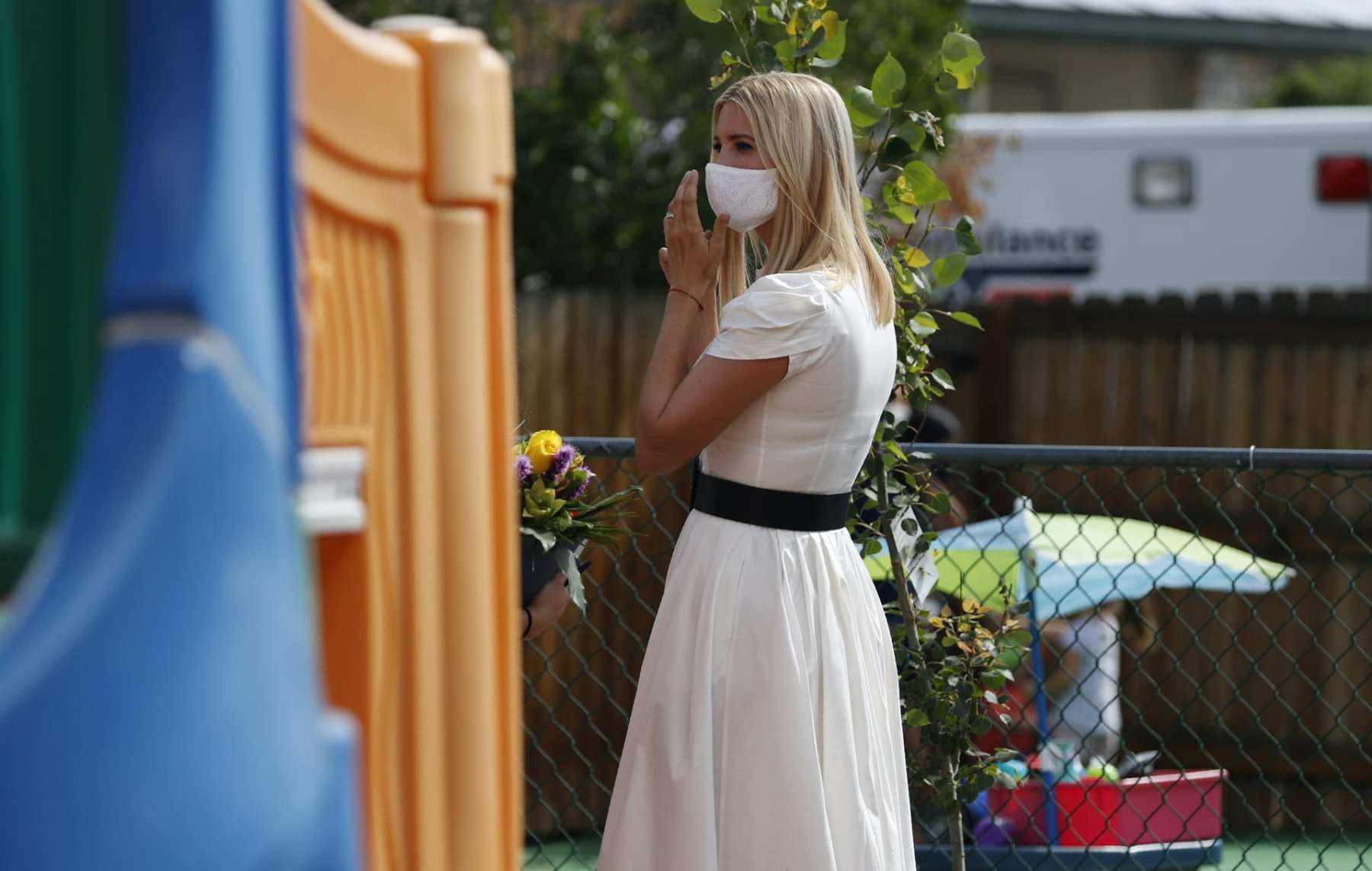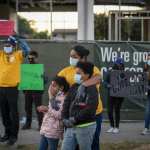We’re the only newsroom dedicated to writing about gender, politics and policy. Subscribe to our newsletter today.
At the White House, Ivanka Trump convened more than a dozen legislators and governors — Republicans and Democrats — to discuss the country’s ailing child care system, an issue the bipartisan coalition all agreed needed attention.
The nation had a “historic chance” to pass paid family leave and child care reform, Trump said, not just because it was an issue disproportionately affecting women, but because it was an economic imperative.
“No mother should have to choose between staying at home with her infant and being fired from her job,” Trump said.
It was December 2019.
Three months after that discussion, the child care system would suffer a nearly fatal encounter with the coronavirus, one that forced daycare closures across the country and thrust more working women than ever into the scenario Trump had outlined just weeks before.
Today, eight months after the onset of the pandemic, one in five child care providers are still out of work. Thousands of centers have closed. As many as half of the nation’s child care slots are at risk of being lost.
But in a Trump administration that once identified child care as a top priority, the topic has become more of a footnote.
It was absent from all three presidential debates and town halls. It’s largely missing from President Trump’s rallies across the nation, where he makes pleas to suburban women to support him. At the Republican National Convention, a week-long opportunity for the administration to tout how it was addressing a wide range of issues important to voters, child care was addressed in much the way it has been handled this year: divorced from the pandemic.
Ivanka Trump, who also serves as an advisor to the president, was the only one to broach the topic in her remarks — but it was brief and in past tense. She spoke of the administration’s greatest success on the issue: raising the child tax credit from $1,000 to $2,000 and increasing the portion of the credit that was refundable.
She didn’t discuss how the issue has worsened — and, critically, what the administration’s plans are to resuscitate child care in a year where women, more than men, are staring down the real possibility of leaving the workforce as a direct result of being unable to find a viable daycare option.
It’s already happening: In September, when many schools resumed virtual education, 865,000 women left the labor force — four times the number of men.
“This conversation of late has gotten wrapped up with the pandemic,” said Jennifer Greenfield, an associate professor at the University of Denver and an expert in child care. “The pandemic has been made into a partisan issue, which then makes child care and paid leave and sick days a very partisan issue.”
That may limit what Trump can say on the topic, Greenfield said, particularly as she campaigns for her father in the final days of the election, hoping to bring in more support from suburban White women — a group that polling indicates has soured on the president.
White House spokesperson Carolina Hurley said in a statement that “this Administration’s commitment to working women and their families remains steadfast as has been evident in every COVID relief package and the proposals we continue to put forward.” But the White House declined to answer questions The 19th asked regarding child care and the pandemic, and declined a request to interview Ivanka Trump.
Carrie Lukas, the president of the Independent Women’s Forum, a conservative nonprofit focused on economic policy issues that affect women, also believes the pandemic has complicated the picture for the Trump administration in terms of addressing child care.
But any attempts to address the issue may be drowned out by criticism, she said, much in the same way the president was criticized for calling for the reopening of schools.
“I can imagine that if she came out and said, ‘It’s time to open daycare centers,’ it would be similar,” said Lukas, who is an expert on child care policy. “This is an administration that gets no credit for being good on working women and being really out front.”
Still, Lukas feels like the stalled discussion around child care, when more people understand the severity of the issue than ever before, could be a missed opportunity.
“It’s been a shame that the politics have prevented so much potential good from happening,” Lukas said. “The administration should try to talk more about their record on issues like this, but I do think they have tried to talk a lot and they’re kind of ignored.”
With only a few days until the election, the chasm between Trump and Biden on female voters remains wide, with most polls putting the gender gap in the double digits, in some instances by more than 20 points.
A majority of voters also support expanding access to affordable child care. But the window is closing on outlining solutions that could draw support from female voters, in particular.
“I do think the president could do much better in talking to women,” Lukas said.
Since the start of the pandemic, Ivanka Trump has attended one event on child care — a roundtable at a Denver daycare called the Bright Beginnings Learning Center, which received a Paycheck Protection Program loan.
“I liked it because child care is in crisis and, at least when she came in, child care was getting recognized,” said Archana Shinde, the center’s owner and director, in an interview with The 19th.
At the event, Trump called Bright Beginnings an “excellent example of how we can safely return to normal, ensuring working parents, children and child care providers are taken care of and prioritized.” Her remarks focused on relief brought by the CARES Act — which included $3.5 billion in child care block grants to keep providers in business — and the PPP loan program, but Democrats called Trump’s visit a “photo op.”
Bright Beginnings’ PPP loan kept the center open, albeit at much lower capacity. Of about 75 or 80 kids the daycare served at the start of the year, only 30 remained when coronavirus first spread. That number has since grown to about 50.
Two months after Trump’s visit, a COVID-19 outbreak hit one of Bright Beginnings’ classrooms, infecting toddlers and teachers and causing the center to shut down for a week and a half. Shinde said she hasn’t heard from the administration again, but didn’t expect to given how busy Trump was likely to be.
In the past few weeks, Trump has been campaigning for her father in crucial states, including North Carolina, Wisconsin, Michigan, Florida and Arizona.
In those nearly two dozen stops, she has touched on child care, but often as a vehicle for speaking about the administration’s prior victories.
The child tax credit is chief among those. The push for that increase, as part of the 2017 tax overhaul, was largely led by Ivanka Trump, who worked behind the scenes to build a coalition of supporters.
But because the credit is designed to increase with a household’s earnings before capping out at $2,000, more than one in three children do not qualify for it because their family earns too little. Even among low-income households, it’s worse for children of color: 53 percent of Black children and 50 percent of Latinx children get partial to no credit, compared to 23 percent of White children, according to a study by Columbia University.
At December’s child care summit, Trump said “there’s still much more work to do” on the subject.
In the administration’s 2021 budget released in early February, the White House again called for a one-time investment of $1 billion to beef up the supply of providers and better reach underserved groups (this was also in the president’s 2020 budget proposal). To get the money, states would be encouraged to reduce regulations that stymie the creation of centers, like eliminating some zoning requirements that keep centers out of residential areas. States could also use the money to incentivize employers to support child care providers or build their own facilities.
The president’s budget is a reflection of priorities for a Trump administration that, at least before coronavirus, hoped to continue making inroads on the issue of child care.
But the only post-pandemic relief for the child care industry that has come so far was in the CARES Act, which included the additional $3.5 billion in funding, as well as offering waivers to daycare providers exempting them from some of the requirements needed to secure child care block grants.
Recent discussions about another round of stimulus have started and stopped multiple times. In a letter to Democrats earlier this month, House Speaker Nancy Pelosi said additional child care funding was among the issues under discussion in the next round of stimulus. Senate Republicans earlier in the year passed a bill that included $15 billion in funding for child care, while Democrats in the House passed several bills that would increase funding by $60 billion.
With continued pushback from both sides, it’s very unlikely another round of stimulus will pass before the election.
“We know [Republicans] can act quickly when they want to,” said Rep. Suzan DelBene, referring to the speedy confirmation of Justice Amy Coney Barrett to the Supreme Court. DelBene, a Democrat from Washington state, has sponsored a child care bill in the House that would expand the tax credit from $2,000 to $3,000 a year for children over the age of 6, and to $3,600 for children under 6. The benefits would be administered monthly so families could access them immediately.
“[Republicans] don’t seem to have a sense of urgency about providing relief for American families,” she said.
Vice President Joe Biden has adopted the plan as part of his presidential platform, which also calls for universal pre-kindergarten for 3- and 4-year-olds.
“If we truly want to reward work in this country we have to ease the financial burden of care that families are carrying,” Biden said at a July speech in Delaware announcing his plan.
During the pandemic, Biden and his surrogates have frequently touted the 10-year, $325 billion proposed investment on the campaign trail.
Earlier this month in Las Vegas, Biden told supporters at a drive-in rally that his administration would “make sure that low- and middle-income families will never have to spend more than 7 percent of their income on care for young children,” one of the pillars of his plan.
In September, Jill Biden led a virtual roundtable with working moms in Colorado to talk about the challenges they’re facing during the pandemic, including a discussion with one mom who is running a campaign for county commissioner, managing a struggling software business and grieving the loss of two grandparents who also played an essential role in the care of her children.
And in an op-ed published on Parents.com last week, Biden’s running mate, Kamala Harris, wrote about the unprecedented challenges facing working families this year.
“The strain on working families, especially women, is simply unacceptable,” Harris wrote. “Joe Biden and I have a plan to get this pandemic under control, reopen schools and child care safely, and build our economy back better so that it truly works for everyone.”
Biden’s campaign has also laid out a larger plan for a “caregiving economy” that includes various child care and elder care proposals. The Trump campaign has not released a child care plan like it did in 2016.
At the December summit on child care, multiple speakers pointed to Ivanka Trump’s work to aid working mothers. Since her father took office, the first daughter has elevated the issue of working women, calling other nations to support women’s economic empowerment and and driving some of the conversation among socially conservative members of Congress around parental leave. She has also worked to expand apprenticeship programs — including for women and minorities in science, technology, engineering and mathematics fields — through her involvement as chair of the White House’s American Workforce Policy Advisory Board.
During the summit, presidential appointee Laurie Todd-Smith, the director of the Women’s Bureau at the Department of Labor, said that “the topics of child care and paid family leave have been elevated over the last few years more than I’ve seen any time in my almost 30 year career so far.” (Todd-Smith declined an interview request from The 19th.)
Rep. Colin Allred, a Texas Democrat who participated in the summit, said he doesn’t believe child care should be a partisan issue, which is why he was glad to take part in the event led by Ivanka Trump.
But the change in tone since the pandemic began has created a “missed opportunity for action this year,” Allred said.
He added that he was “deeply disappointed” that the administration “has not been more engaged on this issue because it impacts so many families.”
The 19th reached out to nine members of Congress who spoke at the December child care summit, but only Allred and Republican Rep. Jackie Walorski responded.
“Strengthening child care for working families is a smart investment that should be a priority as we safely reopen and rebuild our economy,” said Walorski, who represents Indiana, in a statement. “Congress and the administration have taken action to improve access to affordable and high-quality child care, including providing funding and flexibility to support child care providers and strengthen health and safety measures. … We need to continue working together to find commonsense solutions that empower working families and help them thrive.”
A spokesperson for Walorski said she has communicated “extensively” with the administration on child care issues since the start of the pandemic.
But neither Walorski nor the White House would comment on the substance of those discussions.







